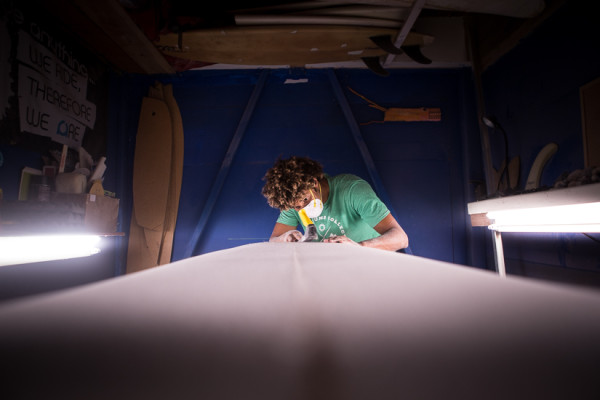
“I do hope there will always be a niche for the rare talents of a master craftsman. Their knowledge may still be ingrained in the fabric of initial designs, and they are valuable for the sake of history alone. But their shaping bays aren’t Hogwarts.” Photo: Alex Smolowe
There’s no soul in foam. The soul of surfing is to get out into the waves and have a good time.” – Al Merrick, LA Times, 1996
Using machines to shape surfboards is not a new concept, but it’s still mildly controversial. Among shapers there are those who embrace the assistance of technology; and there are those so repressed by the past that they consider anything other than a hand-shaped board to be borderline sacrilegious. The majority of this latter group are so blinded by dust and foam that it’s hard to imagine how they eke out a living anymore. I think it’s fair to say that most sensible shapers today employ shaping machines. In terms of efficiency and product quality, they would be mad not to. But the benefits of modern surfboard production reach further than simple economics.
You see, regardless of what shape you choose to float on, a surfboard is a geometric object. A shape which is designed according to the principles of physics to behave a certain way on a wave. In which case–why on earth would you ever risk imperfections or blemishes by ordering a hand-shaped board? If performance is the only concern, why would you think a human being could consistently replicate a desired shape better than a machine?
You know what else is a geometric object? A wheel. There are some brilliant mechanics in the world, but I wouldn’t let any of them shape my tires by hand. Sure, they can channel their expertise into the finer details above the surface, but I’ll have machine shaped wheels, thank you very much.
The reality is that the combination of technology and open source ideas is also the best way to progress board design. In the future we’ll all be our own shapers. The growth of the 3D printing industry will mean that we’ll be banging out everything from surfboards to vital organs.
Despite this, I do hope there will always be a niche for the rare talents of a master craftsman. Their knowledge may still be ingrained in the fabric of initial designs, and they are valuable for the sake of history alone. But their shaping bays aren’t Hogwarts. When I hear people talk of a “magic board” or lament the loss of such a craft, it always makes me laugh. You may be a wizard, Harry, but you’re a damn fool if you didn’t get that board scanned and copied.
When we think of machine shaped boards the term “pop out” is often brandished around like a filthy slur. It conjures images of a plasticy mal spearing through the whitewash towards your face. But these ideas are a little dated. I’ve also heard the anti-machine arguments about copying (or even stealing) the designs of others, but I’m afraid that’s just art, and that’s just life. In board design or otherwise, nothing is truly original.
Many people believe that smart way to work is to blend the old and the new, something which many shapers already do. They feed their expertise into computer software which then designs and cuts the blanks for them, before finishing the board by hand. The tag line from renowned shaper Maurice Cole’s website sums this up as: “Designed by mind. Cut by machine. Shape by hand. Finish with love.” This is very catchy, and nostalgia and tradition are time served selling points in the surf industry, but at the end of the day, love never shaped an effective surfboard, precision did.
Surfing really is an odd sort of chap. We trade in the ethereal. We spend our lives stalking the industry for anything that threatens to take the “soul” out of surfing. We oust the “kooks” from the line-up, and we patrol the forums with spitting vitriol, professing to hate everything about modern surf culture, yet still spending an inordinate amount of time reading about it. I have no idea what the “soul” in surfing is anymore, but I’m pretty sure it’s not a bunch of salty men paddling round with scowls on their faces, desperately trying to avoid eye contact as they gaze stone-faced at the horizon. And you’re deluded if you think this isn’t symbolic of a major cross-section of surf culture.
A recent article on The Inertia bafflingly seemed to catch the attention of a lot of people. The argument against the commercialization of the surf industry is as tired as an old whore. The point about local shapers being phased out in favor of machine made boards sold online has already happened. And what’s wrong with it if consumers get better, cheaper boards? It’s both democracy and globalization, and that’s desirable in any context. More boards sold equals more money for the surf industry as a whole, and more opportunities to advance technology. Sure, your crusty backyard shaper is going to hate it, as is the bitter 40-something who never managed to escape from behind the counter of the surf shop, but who gives a fuck? Surfing is popular. Get over it.
The mentality of many surfers simply needs to evolve. So often we are ousted as the grunting apes of the sporting world, stubbornly crawling on all fours while the world walks off without us. Our time here is short, make the most of it. Whether you’re a full time pro or a weekend warrior, If you value your time in the water, why would you take the risk of having a board potentially spoiled by human hand?

